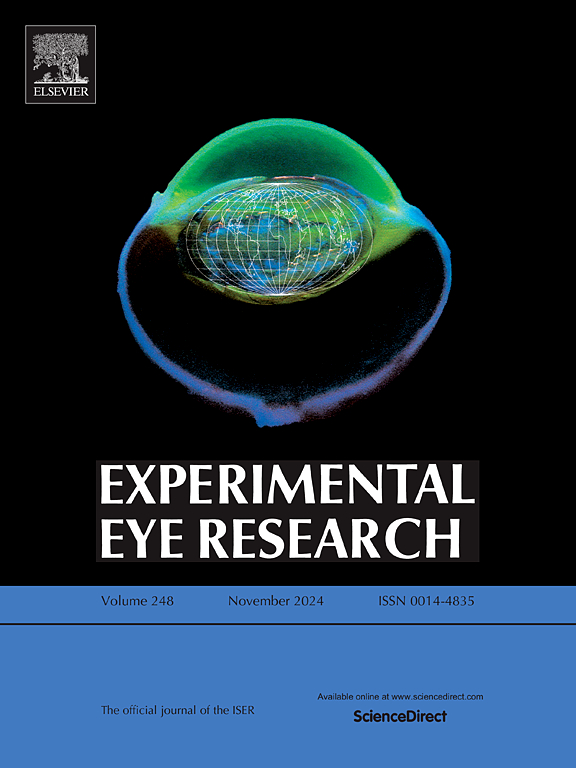miR-29a regulates scleral remodelling via TLR7/8-dependent inflammatory signalling in myopia
IF 3
2区 医学
Q1 OPHTHALMOLOGY
引用次数: 0
Abstract
Myopia, especially high myopia, is a global health concern with a rising prevalence, yet its underlying mechanisms remain incompletely understood. MicroRNAs (miRNAs) have been implicated in the pathogenesis of myopia, potentially playing a critical role in its development. This study aimed to investigate the mechanism by which miR-29a mediates scleral remodelling through the activation of Toll-like receptors (TLRs). By using a form-deprivation myopia (FDM) guinea pig model, we combined fluorescence in situ hybridization (FISH) and qPCR to demonstrate that the expression of miR-29a and inflammatory cytokines (TNF-α and IL-6) was significantly upregulated in the sclera of myopic eyes, whereas TLR7/8 expression remained unchanged. In human scleral fibroblasts (HSFs), FISH and RNA immunoprecipitation (RIP) assays revealed that miR-29a directly interacts with TLR7 and TLR8, forming ligand‒receptor complexes. This interaction activated downstream inflammatory signalling, leading to upregulated expression of proinflammatory cytokines (TNF-α and IL-6), downregulated expression of anti-inflammatory IL-10, and suppression of COL1A1 expression. Inhibition of TLR7/8 signalling reversed these effects, restoring COL1A1 levels and attenuating inflammatory responses. Our findings reveal a novel mechanism by which miR-29a promotes scleral remodelling through TLR7/8-mediated inflammatory signalling, providing new insights into the pathogenesis of myopia and potential therapeutic targets for its prevention and treatment.
miR-29a通过tlr7 /8依赖的炎症信号调节近视的巩膜重塑
近视,特别是高度近视,是一个全球性的健康问题,发病率不断上升,但其潜在机制仍不完全清楚。MicroRNAs (miRNAs)与近视的发病机制有关,可能在其发展中发挥关键作用。本研究旨在探讨miR-29a通过激活toll样受体(TLRs)介导巩膜重塑的机制。通过形态剥夺性近视(FDM)豚鼠模型,我们结合荧光原位杂交(FISH)和qPCR证实,在近视眼巩膜中miR-29a和炎症因子(TNF-α和IL-6)的表达显著上调,而TLR7/8的表达保持不变。在人巩膜成纤维细胞(hsf)中,FISH和RNA免疫沉淀(RIP)检测显示miR-29a直接与TLR7和TLR8相互作用,形成配体-受体复合物。这种相互作用激活下游炎症信号,导致促炎细胞因子(TNF-α和IL-6)表达上调,抗炎IL-10表达下调,COL1A1表达抑制。抑制TLR7/8信号可以逆转这些作用,恢复COL1A1水平并减轻炎症反应。我们的研究结果揭示了miR-29a通过tlr7 /8介导的炎症信号传导促进巩膜重塑的新机制,为近视的发病机制和预防和治疗近视的潜在治疗靶点提供了新的见解。
本文章由计算机程序翻译,如有差异,请以英文原文为准。
求助全文
约1分钟内获得全文
求助全文
来源期刊

Experimental eye research
医学-眼科学
CiteScore
6.80
自引率
5.90%
发文量
323
审稿时长
66 days
期刊介绍:
The primary goal of Experimental Eye Research is to publish original research papers on all aspects of experimental biology of the eye and ocular tissues that seek to define the mechanisms of normal function and/or disease. Studies of ocular tissues that encompass the disciplines of cell biology, developmental biology, genetics, molecular biology, physiology, biochemistry, biophysics, immunology or microbiology are most welcomed. Manuscripts that are purely clinical or in a surgical area of ophthalmology are not appropriate for submission to Experimental Eye Research and if received will be returned without review.
 求助内容:
求助内容: 应助结果提醒方式:
应助结果提醒方式:


